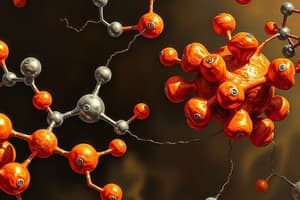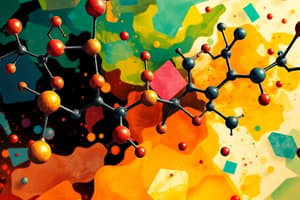Podcast
Questions and Answers
What is the first step in the scientific method?
What is the first step in the scientific method?
- Conducting background research to gather information
- Testing the explanation or educated guess based on available information
- Making an observation about a particular phenomenon or asking a question about it (correct)
- Forming hypotheses and designing experiments or studies
What is a hypothesis in the scientific method?
What is a hypothesis in the scientific method?
- Conducting background research to gather information
- Predicting the outcome of an experiment or observation
- A testable explanation or educated guess based on the available information (correct)
- Making observations about a particular phenomenon or asking questions about it
What does the scientific method aim to assist individuals in determining?
What does the scientific method aim to assist individuals in determining?
- The variety of opinions about a particular phenomenon
- The correctness of their prior knowledge
- Their existing understanding and level of certainty in their knowledge (correct)
- The absolute certainty in their knowledge
What is the purpose of the scientific method?
What is the purpose of the scientific method?
Which type of fatty acid has one or more double bonds (C=C) in their hydrocarbon chains?
Which type of fatty acid has one or more double bonds (C=C) in their hydrocarbon chains?
In which configuration do the hydrogens in a cis double bond lie?
In which configuration do the hydrogens in a cis double bond lie?
What impact does the cis configuration of C=C double bonds have on the fluidity of fats?
What impact does the cis configuration of C=C double bonds have on the fluidity of fats?
What is the primary function of steroids in biological membranes?
What is the primary function of steroids in biological membranes?
What is the composition of a phospholipid?
What is the composition of a phospholipid?
Which type of fats are solid at room temperature?
Which type of fats are solid at room temperature?
What is the role of the phosphate group in a phospholipid?
What is the role of the phosphate group in a phospholipid?
What is the distinguishing feature of unsaturated fatty acids when compared to saturated fatty acids?
What is the distinguishing feature of unsaturated fatty acids when compared to saturated fatty acids?
What defines the type of atom?
What defines the type of atom?
What are isotopes?
What are isotopes?
What are ions?
What are ions?
What measures an atom's ability to attract electrons?
What measures an atom's ability to attract electrons?
What type of bonds involve unequal sharing of electrons?
What type of bonds involve unequal sharing of electrons?
What type of bonds involve the transfer of electrons?
What type of bonds involve the transfer of electrons?
What type of bonds are weak and transient?
What type of bonds are weak and transient?
What unique properties does water exhibit due to extensive hydrogen bonding?
What unique properties does water exhibit due to extensive hydrogen bonding?
What type of molecules may be soluble in water?
What type of molecules may be soluble in water?
What is the backbone of all biological molecules?
What is the backbone of all biological molecules?
How many bonds does a carbon atom typically form?
How many bonds does a carbon atom typically form?
What roles do C-based molecules play in cells?
What roles do C-based molecules play in cells?
What is the scientific method primarily based on?
What is the scientific method primarily based on?
What type of science uses inductive reasoning to form generalizations based on specific observations or evidence?
What type of science uses inductive reasoning to form generalizations based on specific observations or evidence?
What method does hypothesis-based science use to test hypotheses through experimentation?
What method does hypothesis-based science use to test hypotheses through experimentation?
What are the two kinds of hypotheses described in the text?
What are the two kinds of hypotheses described in the text?
What does every experiment require, including positive and negative types?
What does every experiment require, including positive and negative types?
What is fundamental to the scientific method?
What is fundamental to the scientific method?
When are theories accepted in science?
When are theories accepted in science?
What reinforces the validity of experiments?
What reinforces the validity of experiments?
What does Occam's Razor suggest when several explanations are compatible with the evidence at hand?
What does Occam's Razor suggest when several explanations are compatible with the evidence at hand?
What does basic chemistry explain as the basic building blocks of matter?
What does basic chemistry explain as the basic building blocks of matter?
What is deuterium?
What is deuterium?
Which type of isomerism can occur in C-based molecules due to the ability of carbon atoms to form single, double, and triple bonds?
Which type of isomerism can occur in C-based molecules due to the ability of carbon atoms to form single, double, and triple bonds?
What term describes non-superimposable mirror images of each other, occurring when a C atom has 4 different attachments?
What term describes non-superimposable mirror images of each other, occurring when a C atom has 4 different attachments?
How are macromolecules synthesized from monomer subunits?
How are macromolecules synthesized from monomer subunits?
What do polymers consist of?
What do polymers consist of?
How are covalent bonds formed in condensation reactions?
How are covalent bonds formed in condensation reactions?
Why are lipids not considered macromolecules?
Why are lipids not considered macromolecules?
What is the primary function of fats, or triglycerides?
What is the primary function of fats, or triglycerides?
What type of isomerism can occur in C-based molecules when their spatial arrangement around a double bond differs?
What type of isomerism can occur in C-based molecules when their spatial arrangement around a double bond differs?
What are oligosaccharides?
What are oligosaccharides?
What type of bonds make lipids typically insoluble in water?
What type of bonds make lipids typically insoluble in water?
What process forms fats through the covalent attachment of three fatty acids to a glycerol?
What process forms fats through the covalent attachment of three fatty acids to a glycerol?
What is the term for large macromolecules with hundreds to thousands of linked monomer subunits?
What is the term for large macromolecules with hundreds to thousands of linked monomer subunits?
Flashcards are hidden until you start studying
Study Notes
Biological Molecules and Macromolecules
- Carbon atoms can form single, double, and triple bonds, leading to isomerism in C-based molecules
- Enantiomers are non-superimposable mirror images of each other, occurring when a C atom has 4 different attachments
- Macromolecules are large biological molecules composed of many monomer subunits, synthesized through condensation synthesis
- Monomers are the building blocks of polymers, and polymers consist of many linked monomers through covalent bonds
- Condensation reactions form covalent bonds through the loss of a water molecule, while hydrolysis breaks apart bonds with the addition of water
- Carbohydrates, proteins, and nucleic acids are examples of macromolecules, while lipids are not considered macromolecules due to lacking monomer subunits
- Monosaccharides are primarily carbon-based molecules with 5-6 carbon atoms, highly water-soluble, and exist in equilibrium between linear and ring forms
- Oligosaccharides are short chains of 2 or more sugar monomers, formed by condensation synthesis, and can include longer chains up to 16-18 monosaccharide monomers
- Polysaccharides are large macromolecules with hundreds to thousands of linked monomer subunits, poorly water-soluble but hydrophilic
- Lipids are typically not soluble in water due to their non-polar covalent bonds, consisting of fats, phospholipids, and steroids
- Fats, or triglycerides, consist of three fatty acids covalently attached to a glycerol, primarily used as energy storage molecules
- Three condensation reactions release three molecules of water in the process of forming fats.
Studying That Suits You
Use AI to generate personalized quizzes and flashcards to suit your learning preferences.





